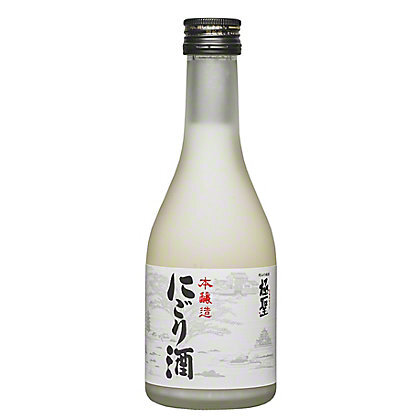Credit for this guide: Sake Story and Niigata Selections
Nigori Sake
Nigori literally means “cloudy sake”.
Nigori is a style rather than a classification.
Nigori style has rice solids (lees) suspended in the sake.
Nigori is technically NOT unfiltered rather it is coarsely pressed (Sake undergoes both pressing and filtration).
Nigori have wide range of texture and sweetness. It can be made in any grade, or style like nama or sparkling!
Nigori goes fabulously with spicy foods
Nigori need to be gently shaken before opening the
bottle unless sparkling style.
• Nigori tend to have shorter shelf life and should always be stored chilled. Aged nigori will turn tan-ish/brown color.
Sake Brewing process at a glance Steps 1-20
MILLING - remove exterior if the rice grains
KARASHI - dry rice to equalize moisture level
WASHING - wash rice to remove bran and other particles
SOAKING & DRAINING - soak rice for water absorbtion
STEAMING
COOLING
RICE KOJI PRODUCTION - inoculate koji mold on steamed rice
SHUBO - prepare fermentation starter
MOROMI - produce sake mash
FERMENTATION - “multiple-parellel fermentation”
ADDING JOZO ALCOHOL (optional)
PRESSING - press sake mash to separate liquid from solids
ORIBIKI - remove ori (sediments in tank)
FILTRATION - remove color from sake and to prevent hiochikin
FIRST PASTEURIZATION - stop yeast & enzyme activity, eliminate hiochikin
AGING - store sake until it achieve optimal flavors
BLENDING AND TASTING
WARIMIZU - dilute sake with water to achieve balanced flavor
SECOND PASTEURIZATION - eliminate any remaining bacteria
BOTTLING - ready for shipment
PRESSING (optional)
For removing the sediment
Brewers have a choice of which style
press
Assaku-ki aka Yabuta Press
Fune Press
Fukurozuri or Tobinkakoi
FILTERING (optional)
To stabilize the sake by removing
protein haze, unwanted color and
smell, extends shelf life.
Activated Charcoal filters
(diatomaceous earth and cellulose)
Non-filtered = Muroka
Fermented mash is poured into bags which are folded
and stacked into a FUNE. Traditionally made of wood but
some modern types are made of other materials like stainless steel.
• Arabashiri = Just stacking the pillow like bags creates a gravity or
free, rough run. Think, young, brash and lively. Usually released in spring just after completion of brewing season.
• Nakadori = The lid is cranked down slowly at first, creating gentle press. This sake is referred to as ‘taken from the middle’ and is generally seen as the best part of the pressing.
• Seme = The lid is cranked further to squeeze the bags and to get every last drop. Most of this press gets mixed in with other less expensive sake.
Shizuku is gravity dripped sake, $$$$ Kindest Press: gravity, gentle, essence and
finesse, time and labor intense.
Cloth bags are filled with fermented mash and hung suspended in the air to drip naturally through gravity one drop at a time!
There are a plethora of ways to make nigori!
➢ Texture of kasu is determined by original milling grade, fermentation type, yeast, koji
➢ Rice type, some varieties dissolve more completely
➢ Honjozo vs Junmai (alcohol helps dissolve rice)
DRAWING SAKE FROM MID LEVELS OF THE TANK
Drier, suspended particles near the top of the tank.
Sweeter heavy lees and undissolved rice at the bottom.
COARSELY PRESSED
• A mesh of varying degrees is used to allow more or less
kasu to sneak into the final brew.
KASU ADDITION
• Fresh kasu is added back into finished sake.
Sacred Mist Nigori
Miyashita Brewery
Producer: Miyashita Brewery
Subregion: Okayama
FeatureNigori
100% Akebono Rice w robust use of rice lees; Akebono is used for both Kojimai and Kakemai
Semaibuai 70%
SMV -25 ~ -30
Yeast: mix of 1601 and 1701
Aromas of toasted coconut & milk chocolate
Honjozo alcohol addition amplifies bright fresh notes
Most importantly: does NOT go through any pressing hence
“ARA-Nigori”. (Creamy thick Nigori)
This Sake is brewed using modern techniques as chosen by our chief distiller.
Along with the history of our Brewery, is our chief distiller's 30 year experience in brewing Sake in the traditional Bichu (western Okayama) manner. Our chief distiller, Akio Nakayama, uses the crystal clear waters of the Asahigawa River and all his energies to distill a wonderfully perky Sake. In order to brew the best Sake in the region, our chief distiller is always searching for ways to improve on perfection.
DAKU means Cloudy or unclear!
DAKU is premium sake; Junmai Grade
Rice: 65% polished, local gohyakumangoku + Koshi Ibuki rice
Water: Myoko Mountain source called Shumi Sen Water, officially rated 3 Star/ superior taste.
Pressed with a roughly woven cloth to allow kasu into brew.
No sugar added, sweetness is a result of koji converting starch to sugar.
The Kobayashi family acquired this brewery in 1916. Their Toji is Kenji Fujii, who has been making sake for four decades at Musashino.
Nigori translates roughly to “cloudy” because of its appearance. Small rice particles are left in the sake resulting in a creamy texture and natural sweetness of the rice, reminiscent of sake straight from the tank. Notes of cinnamon and clove amid the creaminess set Daku apart from other sake in this style. Shake gently before opening and serve chilled.








